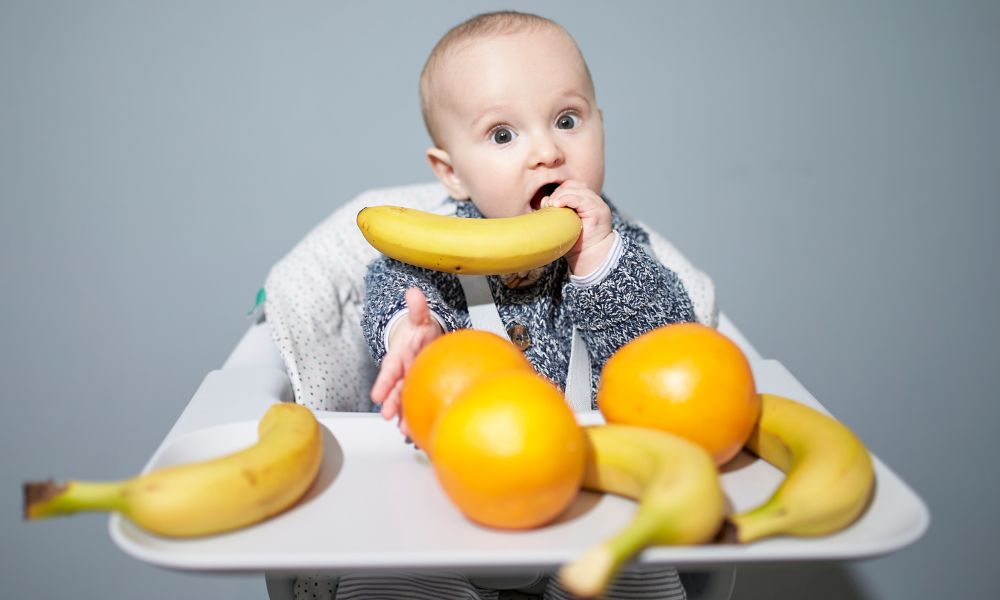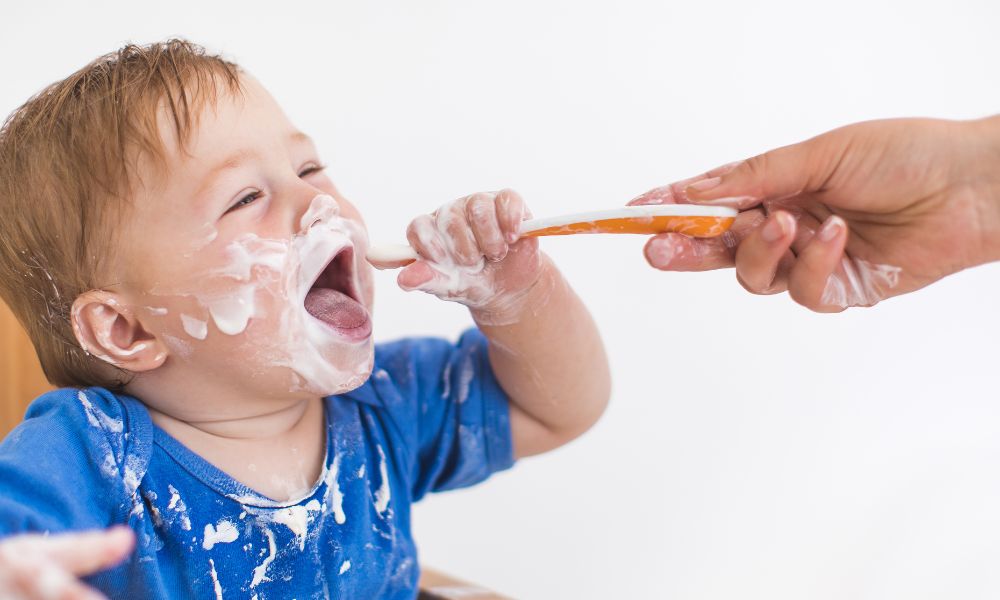Baby-led weaning introduces solid food to babies. Previously, purses and spoon-feeding were used in favor of finger foods that the baby self-feeds. Starting solids is exciting and messy. And sometimes nerve-racking time for many parents. A baby-led weaning method will not help with the mess. However, it may help reduce parental stress. And help to develop a healthy relationship with food. Continue reading for a step-by-step tutorial on how to get started.
What Is Baby-Led Weaning?
Baby-led weaning is providing your baby with several foods. Allowing them to feed themselves. And introducing solids to your child by using baby-led weaning. It allows them to be in control, explore, and select what they pick up and eat. So far, so simple, but here's what else you should know before introducing solids in this manner.
How Do I Start Baby-Led Weaning?
With baby-led weaning, your baby must be able to hold entire pieces of food. And helps bring them to their mouth. Babies typically learn this skill.
First, either on your lap or in a highchair. Place your baby upright, facing the table. Check that they are stable. And they can freely use their hands and arms.
You can begin by offering your baby soft sticks and chunks of food rather than eating them. Try providing them with items such as:
- cooked vegetables
- fruit pasta
- soft foods like bananas or avocado.
When To Start Baby-Led Weaning?
Baby-led weaning should start at 6 months. Allow the baby's digestive and immune systems to develop properly. Your baby should exhibit the following signs of readiness:
- Sits up on his own with good head and neck control.
- The loss of the tongue thrust reflex
- Baby toys or other objects are brought to their mouth.
- Demonstrates an interest in table foods
Benefits Of Baby-Led Weaning

Obesity Risk May Be Lower
Because BLW infants can more remarkably regulate hunger and fullness cues, this method may reduce the risk of obesity later in life. Studies show that toddlers who were weaned using BLW. It had a lower BMI and obesity rate than those who were spoon-fed. They could also not eat in response to food stimuli, such as being offered a snack at a game despite not being hungry.
Exposure To A Wide Range Of Foods
Although studies are insufficient, there is reason to believe. Families who use a baby-led near will expose their infant to a wider variety of foods, including more textures and flavors, than traditional weaning. A wider variety of foods is linked to better quality and health outcomes.
Promotes The Development Of Motor Skills
Self-feeding is an essential component of BLW. It allows babies to grow up and practice fine and gross motor abilities. Babies have more opportunities to practice/ Strength-building movements since they can explore and pick up foods independently.
Minimizes Parental Mealtime Stress
One study surveyed mothers' attitudes toward using a BLW approach. The approach was simple, convenient, and easy to incorporate into family lifestyles and mealtimes. They also reported less stress during mealtimes. And when they are first introducing foods to their babies.
Increases Beneficial Feeding Practices
The impact of parental feeding practices on children's future health outcomes. Implementing baby-led weaning may result in more favorable feeding styles. It being less likely to limit foods or pressure children to eat. However, it is unclear whether parents who choose BLW. It is simply less likely to employ negative feeding strategies. BLW promotes the development of positive feeding practices.
Saves Time And Money
Parents may be planning to make their baby foods. And can save time by simply safely serving family healthy foods. Furthermore, the cost of store-bought baby foods is high. So many families save money by not having to buy these foods.
Is There Any Risk In Baby-Led Weaning?
Overall, baby-led weaning is safe. And it is an effective way to introduce solids to a baby. This method has no higher risk of choking or nutrient deficiency according to research. However, before beginning, parents should be aware of the following concerns.
Mealtimes Can Be Messy.
Babies who start eating solids will get messy — there's no way around it! Exploration and play with food and occasionally missing their mouth are all part of learning to eat. This may not be your place if you can't handle a mess.
Feed your baby in just a diaper to make cleanup easier. And buy wipe-able bibs and a BPA-free silicone suction bowl. Also, buy a washable splash mat for the floors.
The Best Foods for Baby-Led Weaning
Photos of babies eating everything from chicken drumsticks. Casseroles can be found on baby-led-weaning Facebook pages. However, most experts advise starting slowly. "Start with single-ingredient meals, so you'll be able identify any food allergies," DiMaggio says.

Iron-Rich Foods
Iron is in charge of transporting oxygen throughout the body to muscles and organs. And also for promoting brain development in children. Because of rapid growth, needs rise early in life. To ensure your baby gets enough iron, try to include iron-rich foods with every meal if possible.
- Meat (beef, pork)
- Poultry (chicken, turkey)
- Eggs
- Beans
- Lentils
- Tofu
- Fortified breakfast cereal
Protein-Rich Foods
Many protein foods are also high in nutrients. It is essential for babies who eat small amounts of food at a time.
- Meat (beef, pork)
- Poultry (chicken, turkey)
- Fish
- Eggs
- Beans
- Lentils
- Tofu
- Cheese
- Yogurt
- Nut butter
- Whole grains
Fat-Rich Foods
Don't be cheap with the fat! Babies require fat for energy. And help in nutrient absorption. And specific fats, such as omega-3 fatty acids, are vital for brain development.
- Avocado
- Fish
- Full-fat yogurt
- Full-fat cheese
- Olive oil
- Butter
- Nut butter
- Eggs
Vegetables And Fruits
Fruits and vegetables are high in vitamins and minerals. Helping in proper growth and development. They also contain fiber. And early exposure increases babies' chance of enjoying fruits and vegetables later in life.
- Apples (cooked)
- Avocado
- Banana
- Blueberries
- Broccoli (cooked)
- Butternut Squash (cooked)
- Cantaloupe
- Carrots (cooked)
- Cauliflower (cooked)
- Cherries (pitted)
- Cherry Tomatoes
- Cucumbers
- Grapes
- Kiwi
- Mango (very ripe)
- Peaches (very ripe)
- Pears (very ripe)
- Plums (very ripe)
- Potatoes (cooked)
- Raspberries
- Strawberries
- Sweet potatoes (cooked)
- Watermelon
- Zucchini (cooked)
Which Foods To Avoid During Baby-Led Weaning
Babies may want to try new foods at times. But avoid foods that are choking hazards, such as:
- Vegetables that are raw and difficult to chew
- Foods that are cubed or round, such as grapes or sliced, dime-sized hotdogs
- Crunchy, hard foods with a lot of texture, such as chips or popcorn
Is Baby-Led Weaning A Choking Risk?
Choking is a risk for all young children. Choking is more likely in foods that are hard or coin-shaped. And a child is distracted while eating. Indeed, the perceived risk of choking is one of the main reasons for healthcare. Providers are hesitant to endorse BLW fully.
Approximately 35% of babies choke while initially eating food. Primarily because they were given unsafe food. There were no more choking events in babies using BLW. And pureed feeding methods in their first year of life. All babies need to avoid food. It has a link with choking incidents.
Baby-led weaning (BLW) is a way of introducing solids. It focuses on baby self-feeding and serving foods from the family's table. Around 6 months, the baby may show signs of readiness, such as sitting up independently and showing interest in table foods, and BLW may begin.
To begin BLW, ensure you're ready and start with one solid meal daily during family mealtime. Use a highchair in a safe environment, and encourage food exploration and play. Provide suitable soft foods in manageable-sized pieces and allow the baby to lead the feeding process.

